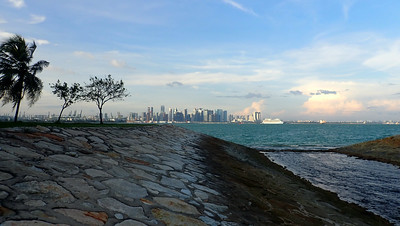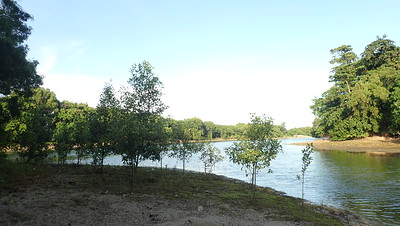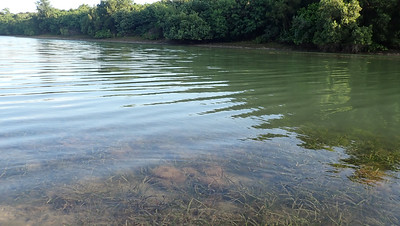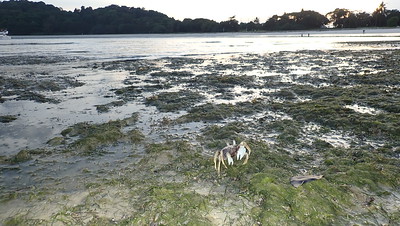Today, I found the lagoon is full of the rare Api-api jambu (Avicennia marina), probably 50 or more trees! Seagrasses have also taken over the lagoon. These have all taken root naturally, without any human planting. Meanwhile, the rest of the team saw THREE Giant clams as they surveyed Lazarus Island. And our skipper sighted THREE sea turtles!
I first saw these rare trees in Nov 2014 but there were not that many at that time. Today, I saw about 10 very tall Api-api jambu (8-10m tall). All were blooming and producing propagules. But almost all of them had curled up or chewed up leaves.
There were many many more shorter trees and saplings. Here's a typical group,
a tall tree surrounded by shorter trees and saplings. All those with yellowish
leaves seem to be Api-Api jambu.
In some places, they practically formed a grove of trees. Like these, which were all about 4m tall.
There were also other kinds of mangroves which are more commonly seen on our shores. These include a lot of Bakau putih, and a few of other kinds like Perepat, Tumu, Api api bulu, Bakau minyak. I also saw some Bakau pasir, which is uncommon on our shores. I noticed that the common mangroves were crammed against the steep edges of the lagoon, while the Api-api jambu grew further into the water. In the photo, a wall of Bakau putih with one small Api- Api jambu growing closer to the water.
Maybe Api-api jambu can tolerate more innudation (there were seaweeds draped quite high up the trees), and may be able to tolerate higher salinity? And grow well in calm waters like in the lagoon - instead of facing the open sea?
In some places, they practically formed a grove of trees. Like these, which were all about 4m tall.
There were also other kinds of mangroves which are more commonly seen on our shores. These include a lot of Bakau putih, and a few of other kinds like Perepat, Tumu, Api api bulu, Bakau minyak. I also saw some Bakau pasir, which is uncommon on our shores. I noticed that the common mangroves were crammed against the steep edges of the lagoon, while the Api-api jambu grew further into the water. In the photo, a wall of Bakau putih with one small Api- Api jambu growing closer to the water.
Maybe Api-api jambu can tolerate more innudation (there were seaweeds draped quite high up the trees), and may be able to tolerate higher salinity? And grow well in calm waters like in the lagoon - instead of facing the open sea?
All the small trees in these photos were Api-api jambu.
More photos of Api-api jambu
in the Seringat secret mangrove lagoon.
The lagoon is also teeming with seagrasses!
Needle seagrass with broad leaves were growing in lush clumps at the low water mark all around the lagoon.
The lagoon is also teeming with seagrasses!
Needle seagrass with broad leaves were growing in lush clumps at the low water mark all around the lagoon.
I saw many patches that look like
Hairy spoon seagrass, which is not very commonly seen on our shores. I also saw patches of regular Spoon seagrass with large leaves.
On the western end of the lagoon, there was a lush patch of
Sickle seagrass.
It was great to also see typical mangrove creatures doing well here. I saw many Stripe-nosed halfbeaks in the water. On the mangrove trees, there were mangrove periwinkles and Belitong. On the ground lots and lots of Bazillion snails and sprinkles of Red berry snails. It's amazing how nature can regenerate spontaneously if we leave her alone!
Here's a map of the places we surveyed.
Seringat-Kias was created by reclaiming two submerged reef flats: Pulau
Seringat and Terumbu Kias. The old boat operators still call the place
Renget. More about the reclamation and development in this
old blog post which highlighted how lots of money and effort was made to make
the artificial Seringat-Kias lagoon look natural: "In 2006, massive
landscaping was reported of the 1km reclaimed beach on Lazarus to
simulate a natural environment so that it would look 'natural and wild'.
5,000 lorry-loads of soil measuring two storeys high when piled up were
brought in by barges, an entire coconut plantation in Malaysia was
bought, about 1, 000 trees was trucked and shipped to the island."
Meanwhile, the neglected secret 'mangrove lagoon' became lush naturally,
without any additional cost.
It was great to also see typical mangrove creatures doing well here. I saw many Stripe-nosed halfbeaks in the water. On the mangrove trees, there were mangrove periwinkles and Belitong. On the ground lots and lots of Bazillion snails and sprinkles of Red berry snails. It's amazing how nature can regenerate spontaneously if we leave her alone!
I realise I'm getting older as I have difficulties getting around
fallen trees on soft mud. Sigh.
I got back to the big Seringat-Kias lagoon at sunset and Ghost crabs were emerging to forage. The sprinkles of Needle and Spoon seagrass (both with narrow and small leaves) are still found at both ends of the lagoon. Three men were using a cast net in the middle of the lagoon, trying to catch small fishes as bait for fishing. They said they couldn't catch much.
There was a huge bloom of Codium seaweed, which washed up in large amounts mixed in with a lot of
Slender crunchy pom-pom red seaweed too. We do often seen blooms of various kinds of seaweeds in this big lagoon. Although there wasn't a seaweed bloom when we last surveyed this shore in Nov 2019.
Mixed in among the seaweeds were the usual single-use plastic cups that we often see in this lagoon. On the high shore, not much litter, but some piles of small plastic pieces. I saw a few abandoned fishing nets entangled around the mangrove trees in the secret lagoon.
Today, for the first time, we arrived in style with Alex and his team and did an amphibious landing in the big artificial lagoon. With the dinghy, we really cut down on the walking on land and got to the shores immediately. It is a long walk around the secret mangrove lagoon, so this made a lot of difference for me!
The best outcome of this arrangement: Alex spotted THREE sea turtles while he waited for us. And kindly shared photos and videos. More about the sightings in this blog post.
The rest of the team explored Lazarus Island and had many great encounters, including THREE giant clams. Two Fluted giant clams, and a Burrowing giant clam. More about their sightings in this blog post.
I got back to the big Seringat-Kias lagoon at sunset and Ghost crabs were emerging to forage. The sprinkles of Needle and Spoon seagrass (both with narrow and small leaves) are still found at both ends of the lagoon. Three men were using a cast net in the middle of the lagoon, trying to catch small fishes as bait for fishing. They said they couldn't catch much.
There was a huge bloom of Codium seaweed, which washed up in large amounts mixed in with a lot of
Slender crunchy pom-pom red seaweed too. We do often seen blooms of various kinds of seaweeds in this big lagoon. Although there wasn't a seaweed bloom when we last surveyed this shore in Nov 2019.
Mixed in among the seaweeds were the usual single-use plastic cups that we often see in this lagoon. On the high shore, not much litter, but some piles of small plastic pieces. I saw a few abandoned fishing nets entangled around the mangrove trees in the secret lagoon.
Today, for the first time, we arrived in style with Alex and his team and did an amphibious landing in the big artificial lagoon. With the dinghy, we really cut down on the walking on land and got to the shores immediately. It is a long walk around the secret mangrove lagoon, so this made a lot of difference for me!
The best outcome of this arrangement: Alex spotted THREE sea turtles while he waited for us. And kindly shared photos and videos. More about the sightings in this blog post.
The rest of the team explored Lazarus Island and had many great encounters, including THREE giant clams. Two Fluted giant clams, and a Burrowing giant clam. More about their sightings in this blog post.

|
|
All photos by
Jianlin Liu. |

|
| from the Southern Islands Development Guide Plan (DGP) 1996 |
The cluster of Kusu, Lazarus and St. John's Islands has been recommended
by the Singapore Blue Plan 2018 for elevated protection status.
The Blue Plan highlights that Lazarus, St. John’s, and Kusu Islands are
established sites for coral nurseries as their shoreline offers ideal
sheltered areas for growth of corals. Designating these islands as
No-fishing Areas can bolster their rehabilitation. Protecting a larger
cluster of islands means zonation plans for use can be implemented to
manage tourism and human impacts.
DOWNLOAD the Plan, SUPPORT the Plan! More on the Singapore Blue Plan 2018 site.
Other surveys on this date
Richard Kuah was at Coney Island
Victor Toh was at Changi Point

|
|
Kusu Island (left) and Lazarus Island (right). |
DOWNLOAD the Plan, SUPPORT the Plan! More on the Singapore Blue Plan 2018 site.
Other surveys on this date
Richard Kuah was at Coney Island
Victor Toh was at Changi Point





















